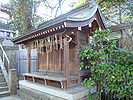
Back Japanische Schreinarchitektur German Architecture shinto French אדריכלות השינטו HE Sintó építészet Hungarian Arsitektur kuil Shinto ID Architettura shintoista Italian 神社建築 Japanese Синтоистская архитектура Russian Shinto architecture SIMPLE Šintoistična arhitektura Slovenian
| Part of a series on |
| Shinto |
|---|
 |
Shinto architecture is the architecture of Japanese Shinto shrines.
With a few exceptions like Ise Grand Shrine and Izumo Taisha Shinto shrines before Buddhism were mostly temporary structures erected to a particular purpose. Buddhism brought to Japan the idea of permanent shrines and the presence of verandas, stone lanterns, and elaborate gates are some which are used both in a Shinto shrine and a Buddhist temple.
The composition of a Shinto shrine is extremely variable, and none of its possible features are necessarily present. Even the honden or sanctuary, the part which houses the kami and which is the centerpiece of a shrine, can be missing. However, since its grounds are sacred, they usually are surrounded by a fence made of stone or wood called tamagaki, while access is made possible by an approach called sandō. The entrances themselves are straddled by gates called torii, which are therefore the simplest way to identify a Shinto shrine.
A shrine may include within its grounds several structures, each destined to a different purpose.[1] Among them are the honden or sanctuary, where the kami are enshrined, the heiden, or hall of offerings, where offers and prayers are presented, and the haiden or hall of worship, where there may be seats for worshipers.[1] The honden is the building that contains the shintai, literally, "the sacred body of the kami". Of these, only the haiden is open to the laity. The honden is located behind the haiden and is usually much smaller and unadorned. Other notable shrine features are the temizuya, the fountain where visitors cleanse their hands and mouth and the shamusho (社務所), the office that supervises the shrine.[1] Shrines can be very large, as for example Ise Shrine, or as small as a beehive, as in the case of the hokora, small shrines frequently found on road sides.
Before the forced separation of Shinto and Buddhism (Shinbutsu bunri), it was not uncommon for a Buddhist temple to be built inside or next to a shrine or to the contrary for a shrine to include Buddhist subtemples (Shinbutsu shūgō). If a shrine was also a Buddhist temple, it was called a jingu-ji. At the same time, temples in the entire country adopted tutelary kami (chinju (鎮守/鎮主) and built temple shrines called chinjusha to house them.[2] After the forcible separation of Buddhist temples and Shinto shrines (shinbutsu bunri) ordered by the new government in the Meiji period, the connection between the two religions was officially severed, but continued nonetheless in practice.
- ^ a b c The History of Shrines, Encyclopedia of Shinto, retrieved on June 10, 2008
- ^ Mark Teeuwen in Breen and Teeuwen (2000:95-96)





